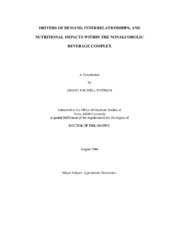| dc.description.abstract | This study analyzes the economic and demographic drivers of household demand for at-home consumption of nonalcoholic beverages in 1999. Drivers of available intake of calories, calcium, vitamin C, and caffeine associated with the purchase of nonalcoholic beverages also are analyzed. The 1999 ACNielsen HomeScan Panel, purchased by the U. S. Department of Agriculture, Economic Research Service, is the source of the data for this project.
Many different classifications of beverages were analyzed including milk(whole, reduced fat, flavored, and non-flavored), regular and low-calorie carbonated soft drinks, powdered soft drinks, isotonics(sports drinks), juices(orange, apple, vegetable, and other juices), fruit drinks, bottled water, coffee(regular and decaffeinated), and tea(regular and decaffeinated).
Probit models were used to find demographic drivers that affect the choice to purchase a nonalcoholic beverage. Heckman sample selection models and cross tabulations were used to find demographic patterns pertaining to the amount of purchase of the nonalcoholic beverages.
The nutrient analysis indicated that individuals receive 211 calories, 217 mg of calcium, 45 mg of vitamin C, and 95 mg of caffeine per day from all nonalcoholic beverages. A critical finding for the nutrient analysis was that persons within households below 130% of poverty were receiving more calories and caffeine from nonalcoholic beverages compared to persons within households above 130% of poverty. Likewise, persons in households below 130% of poverty were receiving less calcium and vitamin C from nonalcoholic beverages compared to persons in households above 130% of poverty.
Price and cross-price elasticities were examined using the LA/AIDS model. Methodological concerns of data frequency, beverage aggregations, and censoring techniques were explored and discussed. Own-price and cross-price elasticities for the beverages were uncovered. Price elasticities by selected demographic groups also were investigated. Results indicated that price elasticities varied by demographics, specifically for race, region, and presence of children within the household.
The information uncovered in this dissertation helps to update consumer demand knowledge and nutritional intake understanding in relation to nonalcoholic beverages. The information can be used as a guide for marketing strategists for targeting and promotion as well as for policy makers looking to improve nutritional intake received from nonalcoholic beverages. | en |


